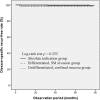Clinical outcome after endoscopic submucosal dissection for early gastric cancer of absolute and expanded indication
- PMID: 28445280
- PMCID: PMC5413245
- DOI: 10.1097/MD.0000000000006710
Clinical outcome after endoscopic submucosal dissection for early gastric cancer of absolute and expanded indication
Abstract
This study evaluated the clinical outcome of endoscopic submucosal dissection (ESD) in minute submucosa (SM) invasion or undifferentiated early gastric cancer (EGC) and analyzed factors related to local recurrence after ESD.We retrospectively reviewed the chart of EGC patients, who underwent ESD at our tertiary hospital between January 2009 and 2015. The patients' characteristics and clinical outcomes were compared among an absolute indication, minute SM invasion, and undifferentiated EGC group.Of 885 total patients, 729 composed the absolute indication group; 65, the differentiated, SM invasion group; and 51, the undifferentiated, confined mucosa group. Follow-up was conducted for average (± standard deviation) 34.12 (± 10.6) months; as compared to the absolute indication group, both en bloc resection and curative resection rate were low in the other 2 groups, but there were no significant differences in procedure-related complication, local recurrence, and survival rate. Comparing the cases of ESD performed at our hospital from 2005 to 2009 with those performed between 2009 and 2015, en bloc resection (80.5% vs 89.1%, P = .001) and curative resection rate (86.2% vs 92.1%, P = .011) were higher in the latter study. Noncurative resection and tumor size of more than 2 cm were factors associated with local recurrence.ESD in minute SM invasion or undifferentiated EGC showed an unfavorable short-term outcome as compared to that in the absolute indication group, but there were no differences in local recurrence and overall survival rate. Therefore, in minute SM invasion or undifferentiated EGC patients, ESD could be recommended as a therapeutic option.
Conflict of interest statement
The authors have no funding and conflicts of interest to disclose.
Figures
Similar articles
-
[Efficacy comparison between surgical resection and endoscopic submucosal dissection of early gastric cancer in a domestic single center].Zhonghua Wei Chang Wai Ke Za Zhi. 2018 Feb 25;21(2):190-195. Zhonghua Wei Chang Wai Ke Za Zhi. 2018. PMID: 29492919 Chinese.
-
Endoscopic Submucosal Dissection of Early Gastric Cancer with Mixed-Type Histology: A Systematic Review.Dig Dis Sci. 2020 Jan;65(1):276-291. doi: 10.1007/s10620-019-05761-w. Epub 2019 Jul 31. Dig Dis Sci. 2020. PMID: 31367880
-
Comparative study between endoscopic submucosal dissection and surgery in patients with early gastric cancer.Surg Endosc. 2018 Jan;32(1):73-86. doi: 10.1007/s00464-017-5640-8. Epub 2017 Jun 21. Surg Endosc. 2018. PMID: 28639042
-
Short- and long-term outcomes of endoscopic submucosal dissection for undifferentiated early gastric cancer.Endoscopy. 2013 Sep;45(9):703-7. doi: 10.1055/s-0033-1344396. Epub 2013 Aug 29. Endoscopy. 2013. PMID: 23990481
-
A Recent Argument for the Use of Endoscopic Submucosal Dissection for Early Gastric Cancers.Gut Liver. 2020 Jul 15;14(4):412-422. doi: 10.5009/gnl19194. Gut Liver. 2020. PMID: 31554392 Free PMC article. Review.
Cited by
-
Primary PCI and Mental Health: A 12-Month Follow-Up Study.Healthcare (Basel). 2023 Jun 1;11(11):1620. doi: 10.3390/healthcare11111620. Healthcare (Basel). 2023. PMID: 37297760 Free PMC article.
-
Extensive small bowel metastasis and peritoneal dissemination 1 year following curative gastrectomy for T1N1 gastric cancer: A case report.Medicine (Baltimore). 2019 Feb;98(5):e13984. doi: 10.1097/MD.0000000000013984. Medicine (Baltimore). 2019. PMID: 30702557 Free PMC article.
-
Risk factors of tumor invasion and node metastasis in early gastric cancer with undifferentiated component: a multicenter retrospective study on biopsy specimens and clinical data.Ann Transl Med. 2020 Mar;8(6):360. doi: 10.21037/atm.2020.02.42. Ann Transl Med. 2020. PMID: 32355804 Free PMC article.
-
Using big data to see the forest and the trees: endoscopic submucosal dissection of early gastric cancer in Korea.Korean J Intern Med. 2019 Jul;34(4):772-774. doi: 10.3904/kjim.2019.170. Epub 2019 Jul 1. Korean J Intern Med. 2019. PMID: 31272143 Free PMC article. No abstract available.
-
Characteristics of proximal early gastric cancer differentiating distal early gastric cancer.PLoS One. 2019 Sep 27;14(9):e0223284. doi: 10.1371/journal.pone.0223284. eCollection 2019. PLoS One. 2019. PMID: 31560720 Free PMC article.
References
-
- Nakamura K, Ueyama T, Yao T, et al. Pathology and prognosis of gastric carcinoma. Findings in 10,000 patients who underwent primary gastrectomy. Cancer 1992;70:1030–7. - PubMed
-
- Rembacken BJ, Gotoda T, Fujii T, et al. Endoscopic mucosal resection. Endoscopy 2001;33:709–18. - PubMed
-
- Soetikno R, Kaltenbach T, Yeh R, et al. Endoscopic mucosal resection for early cancers of the upper gastrointestinal tract. J Clin Oncol 2005;23:4490–8. - PubMed
-
- Japanese Gastric Cancer Association. Japanese classification of gastric carcinoma. 2nd English edition. Gastric Cancer 1998;1:10–24. - PubMed
-
- Gotoda T. Endoscopic resection of early gastric cancer. Gastric Cancer 2007;10:1–1. - PubMed
Publication types
MeSH terms
LinkOut - more resources
Full Text Sources
Other Literature Sources
Medical
Research Materials
Miscellaneous



